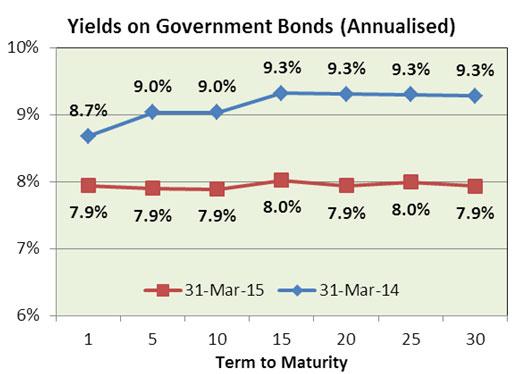Discount Rate for Actuarial Valuations of Employee Benefits (March 2015)
From Actuary's Desk
Discount Rate for Actuarial Valuations of Employee Benefits (March 2015)
The discount rate used in actuarial valuations of employee benefit plans such as gratuity, pension, earned leave etc. is determined by reference to market yields at the balance sheet date on government bonds (refer Para 78 of AS15).
This above means that these valuations are essentially Mark-To-Market (MTM) valuations, which can result in fluctuations in the valuation of liability if the underlying yield on government bonds fluctuates. As can be seen from the below analysis, this is precisely what has happened during the Financial Year 2014-15.
Bond Yields as at March 2015 and March 2014
Yields on the government bonds (and consequently discount rates) have fallen significantly during the financial year.
The chart below presents the comparison of government bond yields of various terms as at 31 March 2015 and 31 March 2014. This information can be used to determine the discount rate to be used for actuarial valuation as per AS15.

* Please note that the yields provided in chart above are interpolated yields in cases where a bond of exact term to maturity is not available. Please note that the government bond yields are quoted on semi-annual basis and yields in above chart have been annualised.
The likely impact of fall in Bond Yields
As you shall notice, the yields on long duration bonds as at 31 March 2015 have fallen by about 1.3% p.a. compared to 31 March 2014.
This fall in bond yields will translate into a fall in discount rate used in actuarial valuations, which is likely to result in significant actuarial loss due to change in assumptions and hence increase in valuation of liability. The increase in liability just because of the above fall in yields can be easily to the tune of 10% to 14% of opening liability.
Without any corresponding offsetting movement on the assets side (remember, AS15 plan assets are also supposed to be valued at fair value), the entire negative impact of fall in discount rates and consequent increase in liability will flow through the expenses.

Could the negative impact have been avoided?
Yes, there are possible solutions of avoiding negative impact of fall in bond yields, most optimum of those being a proper Asset Liability Management (ALM) exercise:
1. Hold Matching Assets
The most optimum solution to this problem lies in doing proper Asset Liability Management (ALM) wherein liability cash flows are matched with asset cash flows (thereby ensuring duration of liability and asset being the same). This will ensure consistent movement in assets, offsetting the impact of fluctuations in discount rates on liability. You can find more on this in our separate paper on “ALM of Employee Benefit Schemes†(to be uploaded shortly).
2. Consistently vary Salary Growth Rate
The Companies may also consider a consistent decrease in salary growth rate (subject to the existing level of salary increase assumption being appropriate). Such a move can help offset the one off movements in liability and is consistent with Para 76 of AS15, which states:
"Actuarial assumptions are mutually compatible if they reflect the economic relationships between factors such as inflation, rates of salary increase, the return on plan assets and discount rates. For example, all assumptions which depend on a particular inflation level (such as assumptions about interest rates and salary and benefit increases) in any given future period assume the same inflation level in that period.â€
I trust you will find the observations and assertions in this note useful. I thank you for reading this note and welcome any comments or recommendations or observations you may have on the subject. You can direct those to the email address mentioned below.
Khushwant Pahwa, FIAI, FIA, B Com (H)
Founder and Consulting Actuary
k.pahwa@kpac.co.in
+91-9910267727

